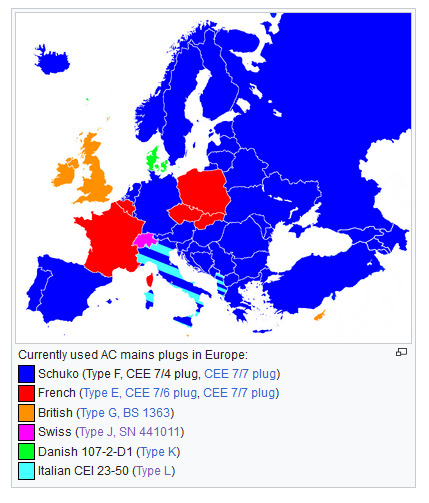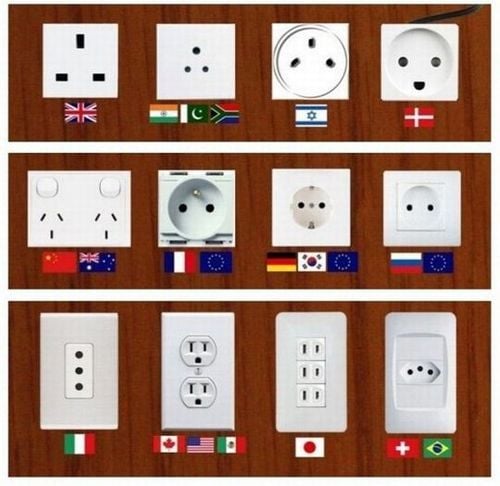I’m not American, but I’ve lived a few years in the US. I find it very interesting that the US invented the electric infrastructure that we use today, but they really screwed up a few things. Firstly, the connectors are far too unsafe. They are flimsy and have no protection from electrocution. Secondly, by using 120V as the main voltage, you need more current to do the same amount of work as a 240V system. Thay means thicker wires, more stress on the plugs, and greater fire hazards.
Shuko plugs FTW
u fool if the plugs functioned consistently and were made intelligently that might cost extra money and would DEMOLISH the rich peoples pockets we cant have that. who’s gonna profit off my taxes?
yeah but it looks like a funny face!
I didn’t know that schuko plugs are the norm for most Europe countries, I thought it was a German thing

https://en.wikipedia.org/wiki/SchukoAlso the french system is compatible with Schuko, so that makes it even more universal.
Yeah I don’t know why we don’t make the switch in France as it wouldn’t be that much of a change
It would be from a financial standpoint. Changing a standard this widely implemented is very costly.
Why change it if they’re compatible anyways? Most devices in the eu are designed to accomodate both, its just a question of the earth pin being different.
I’ve travelled all across europe, coming from a country with the french style outlets. I never had any problems connecting anything except for Switzerland and Italy, because they stuck to their own (inferior) standard thats not compatible with anything else.
The smaller devices like chargers and small lamps have a euro plug that can plug in schucko, danish, italian, swiss, french (but not british)
Common misconception about the voltage though, the US does have a 240v system (well in houses, some places have three phase power which gets weird). The breakers can be wired to give 120v or 240v. The large appliances like driers or electric car chargers and things that do need a large ampunt of current get wired up for that. It’s really only a slightly slower electric kettle to deal with as a minor inconvenience. Or maybe if you wanted an absolutely enormous electric space heater or something, but those are dangerous as it is. Not a lot of things used need more than the 1800 watt maximum. As far as I can tell it’s just a relic of history, Edison ran his generators at about 110v originally and that’s the voltage original light bulb filaments wanted and higher voltage filaments weren’t used until after the US had already been electrifying to a good extent. Theoretically 120v might be a little safer from a getting shocked standpoint, but electrocutions are pretty rare as it is, just a historical artifact and not a conscious design choice as far as I can tell (and yes, volts do matter too, not just amps. Especially if what’s being shocked has very high resistance, like human skin).
Technology connections has a fun video on this too in addition to the plug hole video someone linked elsewhere: https://youtu.be/jMmUoZh3Hq4?si=4a1SCYOZUy-1z2h_
I feel like the US has a very strong resistance to change regarding standards.
The 110v for example used to be the norme in France, but they changed it to 220v in the 50’ and then 230v in the 90’.
Same thing for the plugs, the paper size, the measurement system …
While the US system gets called 110/220, my house actually puts out ~242v. Right now I have a smart plug saying 121.5v.
And since you mentioned the word “plugs”, here are our 220 15a and 20a outlets.


120/240 is the nominal voltage in North America. 110/220 is archaic/colloquial/wrong.
And the standard includes a plus or minus that I don’t remember: it’s unreasonable to expect an exact voltage and everything is built with that in mind
I think “US doesn’t use the metric system” is really overblown. Sure some common things like miles and weights and cooking that people use every day are still done with standard units. But you could say that about many other countries that are “officially” on the metric system. You can’t really force people to stop using units they’re familiar with. Any product I can think of in America is required to have both metric and standard units labeling it. Technical fields like science and medicine don’t touch standard units, would be ridiculous. All metric. If you tell your doctor your weight in lbs it’s instantly converted to kg and that’s what’s used in the system (dosing is done in mg per kg bodyweight often). Every kid in America learns how to use the metric system in school. Construction is probably the big place where it still gets iffy, but even then you can easily get metric or standard bits and things like that. Like what do people want to say we’ve “converted?” Slap all the current cooking/measuring cups out of people’s hands that say both mls and cups, saying no how dare you use cups to measure out the water for your recipe, here have a measuring cup with only mL labeled instead, you’re welcome.
Also ripping out and replacing the entire electrical system of every building in the United States, and scrapping every 120v electrical appliance in the entire country, seems like it would be horrifically expensive and wasteful for some very minor benefits. Maybe a switch could have been made early on in the development of the electrical system, but that ship has sailed. And you can wire up outlets in America for 240v plugs too, the breakers let you do both. So if you need more current for your clothes drier or another large appliance for instance it can be done.
I’ve heard that a lot of countries still have a bunch of legacy infrastructure that was on the older standards too, worldwide. Studd like the widths of plumbing pipes and such. I think the digital era is probably the easiest time to convert. When I drive across the border, the change to metric is effortless on a digital car. Same for basically everything else, 24h time, temperature, etc.
Converting to metric would mean using it in normal speech. You know, like in most civilized countries.
“What’s your height?”
“187 centimeters.”
Type J > Shuko
Type J is safe and a better implementation. I don’t know why the EU didn’t choose type J as a standard.
It cant plug both ways
I think the distinction is we don’t use general purpose 240v receptacles. We only use them as dedicated circuits for built in major appliances. Historically that was sufficient.
We also don’t really use 20a outlets. I don’t know why, especially now that we require 20a circuits in a few places, but you rarely see 20a outlets or appliances with 20a plugs, even though a lot of small appliances could benefit from a little extra power
So is there really a need? Electric kettles are a perfect scenario but what else? Most other use cases for 240v are “built in” appliances not likely to move (welder, air conditioner, laundry, range, etc). Space heaters and hot plates are already dangerous enough that allowing double the current seems like a hazard
Space heaters and hot plates are already dangerous enough that allowing double the current seems like a hazard
You’d require half the current for the same wattage at 240v. At most, it’s the same 15a max, with double the voltage.
Tbh I think I’d rather achieve the same heat output by running them at 240v using less current instead of 110v and pulling as much current as possible/permitted (15a).
Insulation is cheaper than actual conductors too. Higher voltage and lower current means thinner conductors with more insulation to protect them. You’d also remove complexity and thus cost by only needing one voltage. No need for a split phase supply.
I think 240v would be a better option. 🇨🇦
I always thought the holes were there for OSHA lockout/tagout locks.
They are a byproduct of the manufacturing process. There’s a Technology Connections video about it that I’m too lazy to lookup on my phone.
I was bored enough to look up the link
https://www.youtube.com/watch?v=udNXMAflbU8
What is this, the outlet denier?

USA plug should be flipped. The ground should be on top.
Not really. Most plugs I see have ground at the bottom and there’s no official standard for orientation.
No. Ground is on the bottom. Almost always. Unless it’s sideways.
Then just take it out and flip it around. It’s not hard. Just turn off the the circuit at the junction box first.
Yes, except all bulky plugs are designed for plugging into an outlet with the ground at the bottom.
Denmark’s looks happy to supply power
I love that Danish one, always happy to see me!
Americans plugs are very strange
The holes are only for manufacturability.












